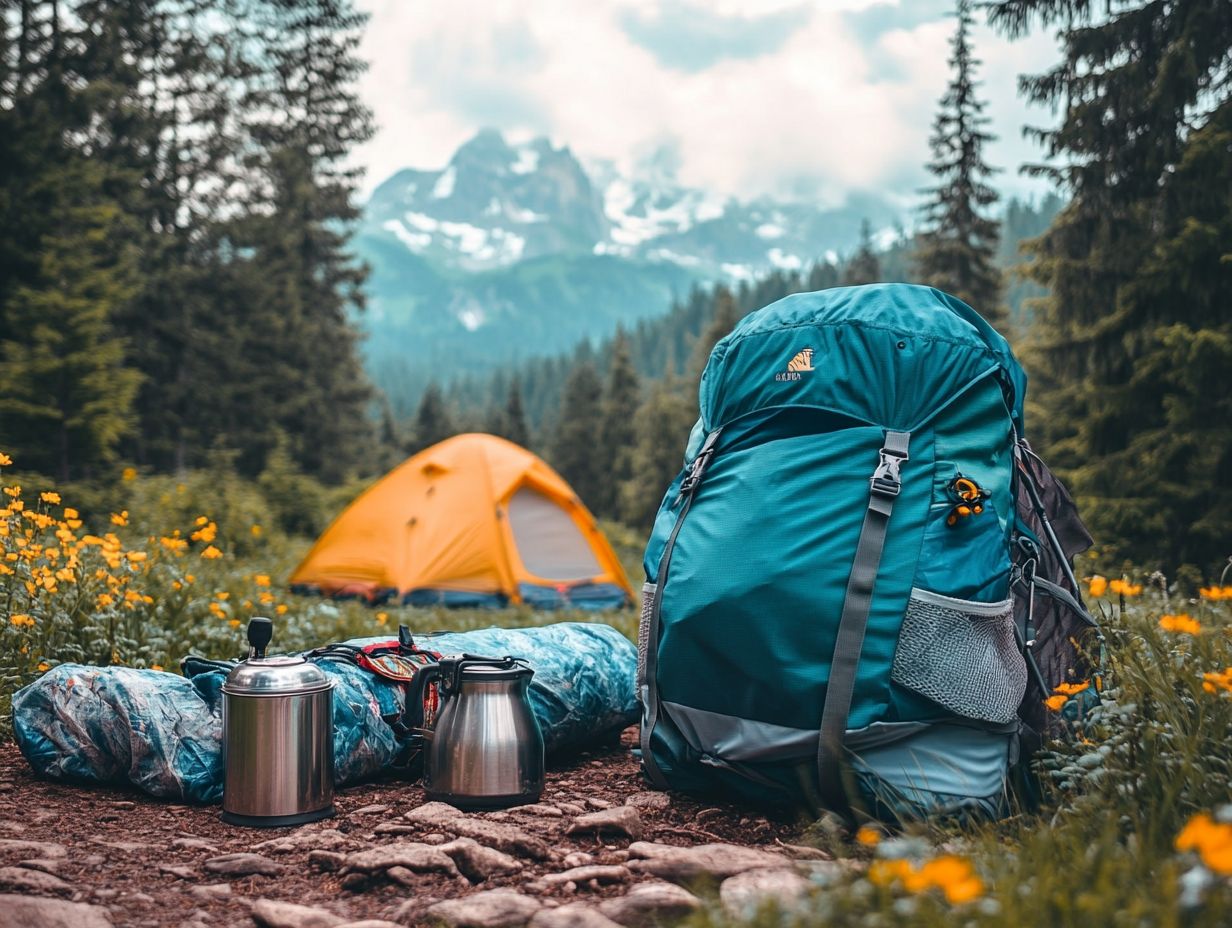What Are the Essentials for Backpacking?
Backpacking offers a unique opportunity to immerse yourself in the great outdoors, but it requires careful planning to ensure your experience is safe and enjoyable.
From selecting the right gear to mastering essential skills, every detail matters on this adventure. This guide will help you create a comprehensive packing list, build your physical stamina, and sharpen your navigation techniques.
This guide also covers trip planning, safety measures, and strategies for managing wildlife encounters. Whether you re heading out for the first time or you re a seasoned hiker, this information will equip you with the knowledge you need for an unforgettable journey!
Contents
- Key Takeaways:
- Preparing for Backpacking
- Essential Skills for Backpacking
- Physical Preparation for Backpacking
- Planning Your Backpacking Trip
- Staying Safe While Backpacking
- Frequently Asked Questions
- What are the essentials for backpacking?
- Do I need a specific type of backpack for backpacking?
- How much water should I bring for backpacking?
- Why is a map and compass important for backpacking?
- What should be included in a first aid kit for backpacking?
- Is it important to consider the weather and terrain when packing for backpacking?
- Backpacking Essentials
Key Takeaways:

- Find the perfect gear for your adventure!
- Develop essential skills like navigation and camping to stay safe and prepared in the wilderness.
- Proper physical preparation and trip planning are crucial for a successful and enjoyable backpacking experience.
Preparing for Backpacking
Preparing for a successful backpacking trip requires careful planning. Start by choosing your lightweight gear, creating a comprehensive gear list, and ensuring you have comfort items like a waterproof liner and an ultralight mattress.
It’s crucial to opt for trustworthy brands consider the Osprey Aura for your backpack and the Big Agnes Tiger for your sleeping system. You might also want to include equipment like the Tarptent Aeon and Zenbivy Light, which provide stability and comfort in various weather conditions.
Choosing the Right Gear
Choosing the right gear is essential for a rewarding backpacking experience. Lightweight gear is often the best choice for maintaining both mobility and comfort on the trail. Brands like Osprey are known for their durable backpacks, while Big Agnes offers reliable sleeping bags and pads. Don t forget to consider Tarptent for effective shelter solutions!
When looking for lightweight backpacks, pay attention to features like adjustable straps and easy-access pockets for added convenience. Ultralight mattresses enhance comfort during long hikes, providing insulation and support for a restful night s sleep.
Compact cooking stoves are essential, allowing you to prepare meals quickly without adding unnecessary weight. Additionally, durable tent stakes will help keep your shelter steady against wind and rain.
Take a moment to assess the quality of these items and read user reviews to determine their functionality and reliability on challenging trails.
Creating a Packing List
Creating a packing list is vital for ensuring you have every necessary item while keeping your load lightweight and manageable. Your gear list should cover essential hiking gear like trekking poles, a rain jacket, and cooking fuel, as well as comfort items such as a camp towel and a portable charger for your devices.
To streamline this process, categorize your items into three main groups: essential gear, comfort items, and meal prep supplies.
Essential gear includes must-have tools like a waterproof pack cover and tent footprint to protect your shelter and belongings from moisture, along with critical safety equipment such as a first aid kit and navigation tools.
Comfort items like a cozy sleeping bag and a lightweight hammock can greatly enhance your camping experience. Meanwhile, meal prep supplies think portable kitchen gear and storage containers are crucial for efficient food storage and preparation, allowing you to enjoy nutritious meals while reveling in the great outdoors.
Essential Skills for Backpacking
Essential skills for backpacking encompass a diverse array of competencies that can greatly elevate your outdoor experience. These include navigation, map reading, and a variety of camping and survival skills.
By mastering these abilities, you enable yourself to plan your routes effectively, interpret weather conditions accurately, and respond adeptly to emergencies. Understanding first aid in the wilderness is crucial, as it underscores the importance of being prepared in any situation you may encounter.
Mastering effective navigation and map reading is essential for any backpacker looking to traverse diverse hiking distances and terrain types with confidence and efficiency.
By learning to read topographic maps (maps that show land features like hills and valleys) and use a personal locator, you can significantly boost your confidence and stay attuned to changing weather conditions during your adventure.
Familiarizing yourself with the symbols that represent trails, rivers, and elevation changes will enable you to plan your route effectively. A compass can be your best friend when the trail becomes ambiguous, while GPS devices provide precise location tracking to keep you on course.
It’s equally important to regularly assess weather conditions while you re on the trail, as shifts can greatly impact your safety and travel times. Smart hikers pay attention to wind patterns, humidity, and cloud formations, enabling them to make informed decisions about their hiking plans.
By honing these navigational skills, you ensure that every hike becomes not just a journey, but a memorable experience.
Camping and Survival Skills
Camping and survival skills are essential for ensuring your safety and comfort while backpacking in the wilderness, blending practical knowledge with a dash of resourcefulness.
Skills like setting up a cooking stove, using a water filter for safe hydration, and administering first aid in emergencies can truly elevate your outdoor experience.
By mastering the art of fire-making, you not only gain warmth but also create a means to cook your meals. A well-set-up tent offers shelter from the elements and enhances your overall comfort.
Understanding the landscape can guide you in successful foraging, helping you identify which plants are safe to eat. In critical situations, being equipped to signal for help or administer CPR can be lifesaving.
These capabilities enable you not just to survive but to thrive, transforming an ordinary trip into an extraordinary and enriching adventure through nature.
Physical Preparation for Backpacking

Physical preparation for backpacking is crucial to ensure you can tackle the challenges of outdoor adventures. This involves committing to dedicated training and conditioning routines specifically designed to align with your hiking goals.
By incorporating strength training, endurance exercises, and flexibility routines into your regimen, you ll enhance your performance and significantly reduce the risk of injuries and facilitate their treatment during your trips.
Training and Conditioning
Training and conditioning for backpacking should center on building your endurance and strength, preparing your body for the physical demands of long hikes and carrying gear.
Incorporating specific hiking gear during your training sessions, such as a weighted backpack, will help simulate the conditions you ll encounter on the trail.
To effectively enhance your stamina and performance levels, various training techniques can be employed. Interval training, which involves alternating between high-intensity activity and rest, can significantly elevate your cardiovascular fitness.
Adding long walks into your routine allows for sustained aerobic conditioning, progressively increasing both distance and duration.
Strength exercises, like squats and lunges, are crucial for fortifying your legs and core, enabling you to better handle inclines and uneven terrain.
As your training progresses, gradually increasing the weight of your backpack and extending the distance of your hikes will lead to remarkable improvements in endurance, making your actual backpacking experience far more enjoyable and manageable.
Injury Prevention and Treatment
Injury prevention and treatment are vital elements of your physical preparation for a successful backpacking experience. They allow you to stay safe and fully enjoy your journey without limitations.
By familiarizing yourself with first aid techniques and understanding common hiking-related injuries such as blisters and sprains, you can arm yourself with effective response strategies.
Being aware of the specific challenges the trail presents like uneven terrain and variable weather conditions enables you to take proactive measures to sidestep common pitfalls. For instance, wearing the right footwear with adequate support can dramatically reduce the risk of ankle injuries.
Investing in quality hiking gear will help prevent falls as well. It s also essential to embrace good stretching techniques before and after your hikes, as tight muscles can lead to strains.
Carrying a comprehensive first aid kit is crucial. Stock it with essentials like antiseptic wipes, gauze, and pain relievers. Knowing how to utilize these supplies can make all the difference in effectively managing any unfortunate accidents that may arise along the way.
Planning Your Backpacking Trip
Planning your backpacking trip requires careful planning to select the perfect location and route. Be sure to account for essential permits and regulations.
Grasping the specific requirements of your chosen destination such as reservation systems or restrictions is vital for ensuring a seamless and enjoyable outdoor adventure. Your attention to these details will set the stage for a truly memorable experience in nature.
Choosing a Location and Route
Choosing the right location and route for your backpacking trip is essential for ensuring an enjoyable and fulfilling experience in nature. When making this decision, consider various factors such as hiking distance, terrain difficulties, and the type of outdoor exploration you wish to pursue.
To discover the ideal trail, reflect on your personal fitness level and the challenges you re ready to embrace. If you thrive on rigorous hikes, you might gravitate toward steep, rocky paths. Conversely, those seeking a more leisurely experience may prefer gentler, scenic routes.
Utilizing resources like hiking apps can provide you with invaluable insights, including user reviews that detail different terrain types and difficulty ratings. Topographic maps are detailed maps showing elevation changes and can highlight scenic hotspots that align with your visual preferences.
With the right tools and a clear sense of self-awareness, planning your perfect hiking adventure can become an exciting part of the journey itself.
Permits and Regulations
Understanding permits and regulations is essential for your responsible backpacking journey. This knowledge ensures you comply with local laws and outdoor ethics while safeguarding the environment.
By researching the specific permit requirements for your destination, you can prevent any unexpected hiccups during your adventure. Don t wait until the last minute to get your permits secure them today!
For instance, many national parks require camping permits to manage visitor numbers and protect fragile ecosystems. In some cases, backcountry access permits may be necessary for areas with restricted entry. These regulations enhance your outdoor experience by preventing overcrowding and help preserve natural habitats for wildlife to thrive undisturbed.
Following these guidelines will make your adventure even more thrilling! By adhering to them, you play a crucial role in minimizing human impact and maintaining the integrity of wilderness areas for future generations. This commitment reflects a growing awareness of the delicate balance between human activity and nature.
Staying Safe While Backpacking
Ensuring your safety while backpacking requires a blend of proactive measures and thorough emergency preparedness. Equip yourself with the skills to handle unexpected situations and hazards in the wilderness to elevate your outdoor experience.
Familiarizing yourself with first aid techniques and grasping the nuances of wildlife safety will greatly enhance your confidence and readiness as you explore the beauty of nature.
Are you ready to explore the trails with confidence?
Emergency Preparedness

Emergency preparedness is an essential aspect of your backpacking safety. It encompasses a range of techniques and tools that equip you to handle unexpected situations with confidence.
A well-stocked first aid kit and a solid grasp of signaling techniques are fundamental elements of your effective emergency plan.
Beyond these basics, consider arming yourself with a multi-tool, which is a handy device that combines several tools in one, a reliable flashlight, and an emergency blanket. These must-have items can be lifesavers when things go wrong outdoors!
It s crucial to have a strategy for quickly communicating your location to rescuers. Tools like a whistle or a signaling mirror can be lifesaving in dense wilderness areas.
Regularly practicing various emergency scenarios with fellow backpackers boosts your confidence. It also fosters group cohesion and sharpens decision-making under pressure.
Engaging in mock drills ensures that everyone knows their roles and can respond instinctively when real danger strikes. This significantly enhances the odds of a safe resolution.
Wildlife Safety
Wildlife safety is paramount for ensuring a secure backpacking experience, especially in areas where potentially dangerous animals roam. Understanding how to prevent encounters with wildlife, like bears, is crucial for your safety in the wilderness.
To minimize such encounters, it s essential to adopt best practices. Proper food storage is a primary measure; using bear-proof containers and hanging food from trees can significantly reduce attractants.
Choosing a campsite away from animal trails and water sources can deter unwanted visitors.
In terms of actual encounters, different animals require specific protocols. For instance, standing your ground and speaking firmly is advised when you come across a bear. Making yourself appear larger is the best approach if you encounter a mountain lion.
Being prepared and informed can make a significant difference in ensuring a safe and enjoyable outdoor adventure.
Frequently Asked Questions
What are the essentials for backpacking?
The essentials for backpacking include a proper backpack, a reliable source of water, a sturdy pair of hiking boots, a map and compass, a first aid kit, and proper clothing and gear for the weather and terrain. It’s also wise to consider what essentials you should carry for budget travel to ensure a smooth trip.
Do I need a specific type of backpack for backpacking?
Yes, it is recommended to use a backpack specifically designed for backpacking. This type will have the necessary features and support for carrying your gear comfortably on long hikes.
How much water should I bring for backpacking?
The general rule of thumb is to bring at least 2 liters of water per day for moderate activities and 4 liters per day for more strenuous activities. It is important to plan ahead and research water sources along your route.
Why is a map and compass important for backpacking?
A map and compass are essential for navigation and can help prevent getting lost on the trail. They also allow you to plan your route and serve as a backup in case your electronic navigation devices fail.
What should be included in a first aid kit for backpacking?
A first aid kit for backpacking should include essentials such as bandages, gauze, pain relievers, antiseptic wipes, and any necessary medication. It is also important to include items specific to your personal medical needs.
Is it important to consider the weather and terrain when packing for backpacking?
Yes, considering the weather and terrain is vital for packing appropriately. This ensures you have the right gear to handle various conditions.
Backpacking Essentials
Yes, it’s vital to consider the weather and terrain when packing for backpacking. This means having suitable clothing and gear for various conditions like rain, cold, and heat.
Don’t forget proper footwear and sun protection!
How much water should I bring?
Bring at least 2 liters of water per day for moderate activities and 4 liters for strenuous ones. Always plan ahead and check water sources along your route.
Why are a map and compass important?
A map and compass are key tools for navigation. They help you plan your route and serve as backups if your GPS or smartphone apps fail.
What should I include in my first aid kit?
Your first aid kit should have bandages, gauze, pain relievers, antiseptic wipes, and any personal medications. Tailor it to your specific needs.







